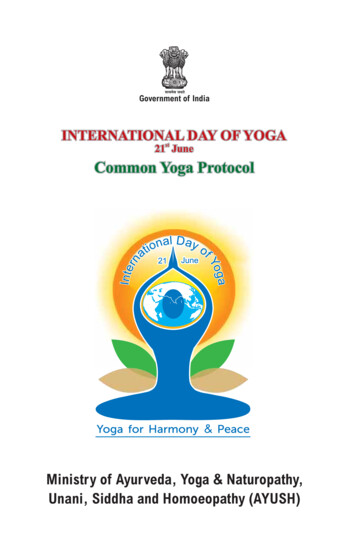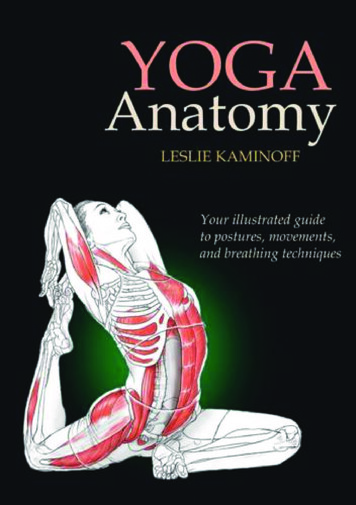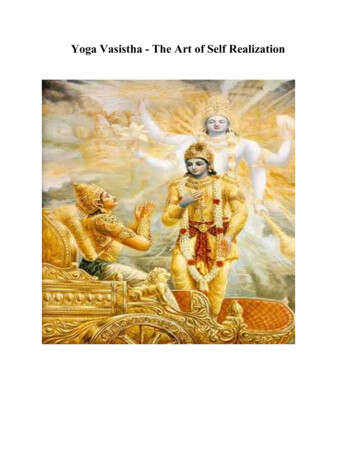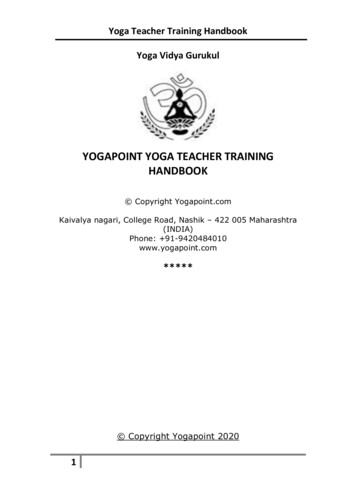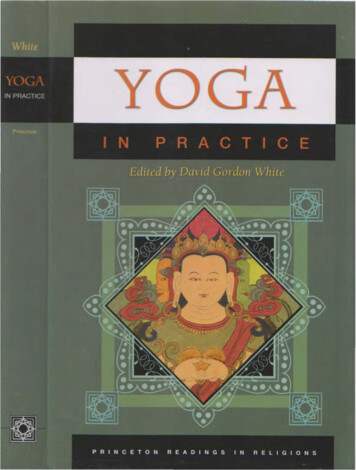
Transcription
I :,.YOGA IN:-. .:'.PRACTICE
PRINCETON READINGS IN RELIGIONSDonaldS. Lopez, Jr., EditorTITLES I N TH E SERIESReligions ofIndia in Practice edited by DonaldS. Lopez,Jr.Buddhism in Practice edited by DonaldS. Lopez,Jr.Religions ofChina in Practice edited by DonaldS. Lopez,Jr.Religions ofT ihet in Practice edited by DonaldS. Lopez,Jr.Religions ofJapan in Practice edited by George J. Tanabe,Jr.Religions ofAsia in Practice: An Anthology edited by DonaldS. Lopez,Jr.Religions ofLate Antiquity in Practice edited by Richard ValantasisTantra in Practice edited by David Gordon Whitejudaism in Practice: From the Middle Ages through the Early ModernPeriod edited by Lawrence FineReligions ofthe UnitedStates in Practice, Volumes 1 and 2edited by Colleen McDannellReligions ofAsia in Practice: An Anthology edited by DonaldS. Lopez,Jr.Religions ofKorea in Practice edited by Robert E. Buswell,Jr.1he Historical jesus in Context edited by Amy-Jill Levine,Dale C. Allison Jr., and John Dominic CrossanMedieval Christianity in Practice edited by Miri RubinIslam inSouth Asia in Practice edited by Barbara D. MetcalfYoga in Practice edited by David Gordon White
YOGAI NPR AC TICEEdited byDavid Gordon WhitePRINCETON READINGS IN RELIGIONSPRINCETON UNIVERSITY PRESSPRINCETON AND OXFORD
Copyright 2012 by Princeton University PressPublished byPrinceton University Press, 41 William Street, Princeton, N ewJersey 08540In the United Kingdom: Princeton University Press, 6 Oxford Street,Woodstock,Oxfordshirc OX20 1TWAll Rights ReservedISBN : 978-0-691-14085-8ISBN (pbk.): 978-0-691-14086-5Library ofCongressControl N umber: 2011934245BritishLibraryCataloging-in-Publication Data is availableThis book has been composed inAdobeCaslon Pro withCharlemagne Std DisplayPrinted on acid-free paper oopress. princeton.eduPrinted in the United States ofAmerica13579108642
CONTENTSviiixContents by TraditionContents by CountryContributorsxiIntroduction David Gordon WhiteNote for Instructors . David Gordon1.24WhiteFoundational Yoga Texts1. The Path to Liberation through Yogic Mindfulness in EarlyAyurveda . Dominik Wujastyk2. A Prescription for Yoga and Power in the Mahabharata. james L . Fitzgerald3. Yoga Practices in the Bhagavadgita Angelika Malinar4. Patafijala Yoga in Practice . Geraldjames Larson5. Yoga in the Yoga Upaniiads: Disciplines of the Mystical OM·Sound . Jeffrey Clark Ruff6. The Sevenfold Yoga of the Yogavas#tha·7. A Fourteenth-Century Persian Account of Breath Control and. Carl W. ErnstYoga in Jain, Buddhist, and Hindu Tantric Traditions8. A DigambaraJain Description of the Yogic Path to9.10.11.12.3143587397ChristopherKey ChappleMeditation29Deliverance . Paul DundasSaraha's Queen Dohas . Roger R. ]acksonThe Qyestions and Answers ofVajrasattva . jacob P. DaltonThe Six-Phased Yoga of the Abbreviated Wheel ofTime Tantra(Laghukalacakratantra) according toVajrapaQi . VesnaA. WallaceEroticism and Cosmic Transformation as Yoga: The .Atmatattvaof the Vai Qava Sahajiyas of Bengal . Glen Alexander Hayes117133141143162185204223
viCON T E N TS13. The Transport of the Harpsas: A Sakta Rasalila as Rajayoga inEighteenth-Century Benares . Somadeva VasudevaYoga of the Nath Yogis14. The Original Gorak!afataka . James Mallinson15. Nath Yogis, Akbar, and the "Balnath Tilla" . William R. Pinch16. Yogic Language in Village Performance: Hymns of theHouseholder Naths . Ann Grodzins Gold and Daniel Gold242255257273289Yoga in the Colonial and Post-Colonial Periods30717. The Yoga System of theJosmanis . Sthaneshwar Timalsina18. Songs to the Highest God (lsvara) of Srupkhya-Yoga309Knut A. jacobsenYoga Makaranda of T. Krishnamacharya . Mark Singleton, M.Narasimhan, and M. A. ]ayashree·19.20. Theos Bernard and the Early Days of Tantric Yoga in America·Paul G. Hackett32533735321. Universalist and MissionaryJainism:Jain Yoga of the TerapantruTradition Olle Qvarnstriim andjason Birch365Glossary ofForeign TermsIndex383389.
CONTENTSBY TRA D ITIONBuddhism9. Saraha's Queen Dohtis10. The Qyestions and Answers ofVajrasattva11. The Six-phased Yoga of the Abbreviated Wheel ofTime Tantra(Laghuktilacakratantra) According to Vajrapal)i162185204Hinduism1. The Path to Liberation through Yogic Mindfulness inEarly Ayurveda2. A Prescription for Yoga and Power in the Mahtibhtirata3. Yoga Practices in the Bhagavadgitti4. Pataiijala Yoga in Practice5. Yoga in the Yoga Upani ads: Disciplines of the MysticalOJ1.:1Sound6. The Sevenfold Yoga of the Yogavtisi tha12. Eroticism and CosmicTransformation as Yoga: The Atmatattvaof the Vai Qava Sahajiyas of Bengal13. TheTransport of the Harpsas: A Sakta Rasalila as Rajayoga inEighteenth-Century Benares14. The Original Gora/qafataka15. Nath Yogis, Akbar, and the "Balnath Tilla"16. Yogic Language in V illage Performance: Hymns of theHouseholder Naths17. The Yoga System of the Josmanis18. Songs to the Highest God (i5vara) ofSarpkhya-Yoga19. Yoga Makaranda ofT. Krishnamacharya20. Theos Bernard and the Early Days ofTantric Yoga in am7. A Fourteenth-Century Persian Account of Breath Controland Meditation133
viiiCON T E N TSB Y TRA D I TI O NJainism8. A Digambara Jain Description of the Yogic Path to Deliverance21. Universalist and Missionary Jainism: Jain Yoga of theTerapanthi Tradition143365
CONTENTSBYCOUNTRYEngland21. Universalist and Missionary Jainism: Jain Yoga of theTerapanthi Tradition365India1. The Path to Liberation through Yogic Mindfulness inEarly Ayurveda2. A Prescription for Yoga and Power in the Mahabharata3. Yoga Practices in the Bhagavadgita4. Pataiijala Yoga in Practice5. Yoga in the Yoga Upaniiads: Disciplines of the MysticalO Sound6. The Sevenfold Yoga of the Yogavasii{ha8. A DigambaraJain Description of the Yogic Path to Deliverance12. Eroticism and Cosmic Transformation as Yoga: The Atmatattvaof the Vai Qava Sahajiyas of Bengal13. The Transport of the Harpsas: A Sakta Rasalila as Rajayoga inEighteenth-Century Benares14. The Original Gora afataka15. Nath Yogis, Akbar, and the "Balnath Tilla"16. Yogic Language in Village Performance: Hymns of theHouseholder Naths18. Songs to the Highest God (Isvara) of Sarp.khya-Yoga19. Yoga Makaranda ofT. 37Iran7. A Fourteenth-Century Persian Account of Breath Control andMeditation133
XC O N T E N T S B Y C O U NT RYNepal17. The Yoga System of theJosmanis309Tibet9. Saraha's Queen Dohtis10. The Qyestions and Answers of Vajrasattva11. The Six-Phased Yoga of the Abbreviated Wheel ofTime Tantra(Laghuktilacakratantra) according to Vajrapat:ll162185204United States20. Theos Bernard and the Early Days ofTantric Yoga in America353
CONTRI BUTORSJason Birch is reading for a Ph.D. in Oriental Studies at Oxford University.He also teaches Hatha Yoga in Singapore,Japan, and Australia.Christopher Key Chapple is Doshi Professor ofindic and Comparative The ology at Loyola Marymount University, Los Angeles.Jacob P. Dalton teaches Tibetan and Buddhist Studies at the University ofCalifornia, Berkeley.Paul Dundas is a Reader in Sanskrit in the Department of Asian Studies atthe University of Edinburgh, United Kingdom.Carl W. Ernst is William R. Kenan,Jr., Distinguished Professor of ReligiousStudies at the University of North Carolina at Chapel Hill.James L. Fitzgerald is the Das Professor of Sanskrit in the Department ofClassics at Brown University, Providence, Rhode Island.Ann Grodzins Gold is a professor in the Departments of Religion and An thropology at Syracuse University, New York.Daniel Gold teaches in the Department of Asian Studies at Cornell Univer sity, Ithaca, New York.Paul G. Hackett holds a research position in the Center for Buddhist Studiesat Columbia University, New York.Glen Alexander Hayes teaches in the Religion Program at Bloomfield Col lege, Bloomfield, NewJersey.RogerJackson isJohn W. Nason Professor of Asian Studies and Religion atCarleton College, Northfield, Minnesota.Knut A. Jacobsen is professor in Religious Studies at the University of Ber gen, Norway.M. A.Jayashree is a research scholar at the Anantha Research Foundation inM ysore, India.Gerald James Larson is Tagore Professor Emeritus, Indiana University,Bloomington, and Professor Emeritus, Religious Studies, University ofCalifornia, Santa Barbara.Angelika Malinar is Professor ofindology at the University of Zurich.James Mallinson is an independent scholar living in England.
xiiCONTRIBUTORSM. Narasimhan is a research scholar at the Anantha Research Foundation inMysore, India.William R. Pinch teaches in the Department of History at Wesleyan Univer sity, Middletown, Connecticut.ODe Qvarnstrom teaches in the Department of History of Religions at theUniversity of Lund, Sweden.Jeffrey Clark Ruff teaches in the Department of Religious Studies at Mar shall University, West Virginia.Mark Singleton teaches at St.John's College, Santa Fe, New Mexico.Sthaneshwar Timalsina teaches in the Department of Religious Studies atSan Diego State University.Somadeva Vasudeva is Assistant Professor of Sanskrit at Columbia Univer sity, New York.Vesna Wallace teaches in the Department of Religious Studies at the Univer sity of California, Santa Barbara.David Gordon White is theJ. F. Rowny Professor of Comparative Religionsat the University of California, Santa Barbara.Dominik Wujastyk is a Research Fellow at the Institute of South Asian,T i betan, and Buddhist Studies at the University of Vienna, Austria.
YOGA INPRACTICE
jjjjjjjjjjjjj
Yoga, Brief History of an IdeaDavid Gordon WhiteOver the past decades, yoga has become part of the Zeitgeist of affiuent west ern societies, drawing housewives and hipsters, New Agers and the old-aged,and body culture and corporate culture into a multibillion-dollar synergy. Likeevery Indian cultural artifact that it has embraced, the West views Indian yogaas an ancient, unchanging tradition, based on revelations received by the Vedicsages who, seated in the lotus pose, were the Indian forerunners of the flat tummied yoga babes who grace the covers of such glossy periodicals as theYoga journal and Yoga Internationa/.1In the United States in particular, yoga has become a commodity. Statisticsshow that about 16 million Americans practice yoga every year. For most peo ple, this means going to a yoga center with yoga mats, yoga clothes, and yogaaccessories, and practicing in groups under the guidance of a yoga teacher ortrainer. Here, yoga practice comprises a regimen of postures (asanas)-some times held for long periods of time, sometimes executed in rapid sequence often together with techniques of breath control (prti7Jtiytima). Yoga entrepre neurs have branded their own styles of practice, from Bikram's superheatedworkout rooms to studios that have begun offering "doga,, practicing yogatogether with one's dog. They have opened franchises, invented logos, pack aged their practice regimens under Sanskrit names, and marketed a lifestylethat fuses yoga with leisure travel, healing spas, and seminars on eastern spiri tuality. "Yoga celebrities" have become a part of our vocabulary, and with ce lebrity has come the usual entourage of publicists, business managers, and1 Inthis introduction, names in [square brackets] refer to contributions found in this volume,while references in (parentheses) refer to works found in Works Cited at the end of thischapter.
2D AV I D G O R D O N W H I T Elawyers. Yoga is mainstream. Arguably India's greatest cultural export, yoga hasmorphed into a mass culture phenomenon.Many yoga celebrities, as well as a strong percentage of less celebrated yogateachers, combine their training with teachings on healing, spirituality, medi tation, and India's ancient yoga traditions, the Sanskrit-language Yoga Sutra(YS) in particular. Here, they are following the lead of the earliest yoga entre preneurs, the Indian gurus who brought the gospel of yoga to western shoresin the wake of Swami Vivekananda's storied successes of the late nineteenthand early twentieth centuries.But what were India's ancient yoga traditions, and what relationship dothey have to the modern postural yoga (Singleton 2010) that people are prac ticing across the world today? In fact, the yoga that is taught and practicedtoday has very little in common with the yoga of the YS and other ancientyoga treatises. Nearly all of our popular assumptions about yoga theory datefrom the past 150 years, and very few modern-day practices date from beforethe twelfth century. This is not the first time that people have "reinvented"yoga in their own image. As the contributions to this volume demonstrate,this is a process that has been ongoing for at least two thousand years. Everygroup in every age has created its own version and vision of yoga. One reasonthis has been possible is that its semantic field-the range of meanings of theterm "yoga"-is so broad and the concept of yoga so malleable, that it hasbeen possible to morph it into nearly any practice or process one chooses.W hen seeking to define a tradition, it is useful to begin by defining one'sterms. It is here that problems arise. "Yoga" has a wider range of meaningsthan nearly any other word in the entire Sanskrit lexicon. The act of yoking ananimal, as well as the yoke itself, is called yoga. In astronomy, a conjunction ofplanets or stars, as well as a constellation, is called yoga. When one mixes to gether various substances, that, too, can be called yoga. The word yoga has alsobeen employed to denote a device, a recipe, a method, a strategy, a charm, anincantation, fraud, a trick, an endeavor, a combination, union, an arrangement,zeal, care, diligence, industriousness, discipline, use, application, contact, a sumtotal, and the Work of alchemists. But this is by no means an exhaustive list.So, for example, the ninth-century Netra Tantra, a Hindu scripture fromKashmir, describes what it calls subtle yoga and transcendent yoga. Subtleyoga is nothing more or less than a body of techniques for entering into andtaking over other people's bodies. As for transcendental yoga, this is a processthat involves superhuman female predators, called yogin is, who eat people! Byeating people, this text says, the yoginis consume the sins of the body thatwould otherwise bind them to suffering rebirth, and so allow for the "union''(yoga) of their purified souls with the supreme god Siva, a union that is tanta-
I N T R O D U CT I O N3mount to salvation (White 2009: 162-63). In this ninth-century source, thereis no discussion whatsoever of postures or breath control, the prime markersof yoga as we know it today. More troubling still, the third- to fourth-centuryCE YS and Bhagavad Gitti (BhG), the two most widely cited textual sourcesfor "classical yoga,"virtually ignore postures and breath control, each devotinga total of fewer than ten verses to these practices.They are far more concernedwith the issue of human salvation, realized through the theory and practice ofmeditation (dhyana) in the YS [Larson] and through concentration on thegod Kr r:ta in the BhG [Malinar].Indian Foundations ofYoga Theory and PracticeClearly something is missing here. There is a gap between the ancient, "classi cal"yoga tradition and yoga as we know it. In order to understand the discon nect between then and now, we would do well to go back to the earliest uses ofthe term yoga, which are found in texts far more ancient than the YS or BhG.Here I am referring to India's earliest scriptures, the Vedas. In the circa fif teenth-century BCE /!.g Veda, yoga meant, before all else, the yoke one placedon a draft animal-a bullock or warhorse--to yoke it to a plow or chariot. Theresemblance of these terms is not fortuitous: the Sanskrit "yoga"is a cognate ofthe English "yoke," because Sanskrit and English both belong to the Indo European language family (which is why the Sanskrit matr resembles the Eng lish "mother," sveda looks like "sweat," udara-"belly" in Sanskrit-looks like"udder," and so forth). In the same scripture, we see the term's meaning ex panded through metonymy, with "yoga"being applied to the entire conveyanceor "rig" of a war chariot: to the yoke itself, the team of horses or bullocks, andthe chariot itself with its many straps and harnesses. And, because such chariotswere only hitched up (yukta) in times of war, an important Vedic usage of theterm yoga was "wartime,"in contrast to kfema, "peacetime."The Vedic reading of yoga as one's war chariot or rig came to be incorpo rated into the warrior ideology of ancient India. In the Mahabharata, India's200 BCE-400 CE "national epic," we read the earliest narrative accounts ofthe battlefield apotheosis of heroic chariot warriors. This was, like the GreekIliad, an epic of battle, and so it was appropriate that the glorification of awarrior who died fighting his enemies be showcased here.What is interesting,for the purposes of the history of the term yoga, is that in these narratives, thewarrior who knew he was about to die was said to become yoga-yukta, literally"yoked to yoga,"with "yoga"once again meaning a chariot. This time, however,it was not the warrior's own chariot that carried him up to the highest heaven,
4D AV I D G O R D O N W H I T Ereserved for gods and heroes alone. Rather, it was a celestial "yoga," a divinechariot, that carried him upward in a burst of light to and through the sun,and on to the heaven of gods and heroes.Warriors were not the sole individuals of the Vedic age to have chariotscalled "yogas." The gods, too, were said to shuttle across heaven, and betweenearth and heaven on yogas. Furthermore, the Vedic priests who sang the Vedichymns related their practice to the yoga of the warrior aristocracy who weretheir patrons. In their hymns, they describe themselves as "yoking" their mindsto poetic inspiration and so journeying-if only with their mind's eye or cog nitive apparatus-across the metaphorical distance that separated the worldof the gods from the words of their hymns. A striking image of their poeticjourneys is found in a verse from a late Vedic hymn, in which the poet-priestsdescribe themselves as "hitched up" (yukta) and standing on their chariotshafts as they sally forth on a vision quest across the universe.The earliest extant systematic account of yoga and a bridge from the earlierVedic uses of the term is found in the Hindu Ka{haka Upanifad (KU), a scrip ture dating from about the third century BCE. Here, the god of Death revealswhat is termed the "entire yoga regimen" to a young ascetic named Naciketas.In the course of his teaching, Death compares the relationship between theself, body, intellect, and so forth to the relationship between a rider, his chariot,charioteer, etc. (KU 3.3-9), a comparison which approximates that made inPlato's Phaedrus. Three elements of this text set the agenda for much of whatconstitutes yoga in the centuries that follow. First, it introduces a sort of yogicphysiology, calling the body a "fort with eleven gates" and evoking "a personthe size of a thumb" who, dwelling within, is worshiped by all the gods (KU4.12; 5.1, 3). Second, it identifies the individual person within with the univer sal Person (purura) or absolute Being (brahman), asserting that this is whatsustains life (KU 5.5, 8-10). Third, it describes the hierarchy of mind-bodyconstituents-the senses, mind, intellect, etc.-that comprise the founda tional categories of Saqtkhya philosophy, whose metaphysical system groundsthe yoga of the YS, BhG, and other texts and schools (KU 3.10-11; 6.7-8).Because these categories were hierarchically ordered, the realization of higherstates of consciousness was, in this early context, tantamount to an ascensionthrough levels of outer space, and so we also find in this and other early Upa ni ads the concept of yoga as a technique for "inner" and "outer"ascent. Thesesame sources also introduce the use of acoustic spells or formulas (mantras),the most prominent among these being the syllable OM, the acoustic form ofthe supreme brahman. In the following centuries, mantras would become pro gressively incorporated into yogic theory and practice, in the medieval Hindu,Buddhist, and Jain Tantras, as well as the Yoga Upanifads.
I NTRO D UCTI O N5Following this circa third-century BCE watershed, textual references toyoga multiply rapidly in Hindu,Jain, and Buddhist sources, reaching a criticalmass some seven hundred to one thousand years later. It is during this initialburst that most of the perennial principles of yoga theory-as well as manyelements of yoga practice--were originally formulated.Toward the latter endof this period, one sees the emergence of the earliest yoga systems, in the YS;the third- to fourth-century scriptures of the Buddhist Yogacara school andfourth- to fifth-century Visuddhimagga of Buddhagho a; and the Yogadnti samuccaya of the eighth-century Jain author Haribhadra. Although the YSmay be slightly later than the Yogacara canon, this tightly ordered series ofaphorisms is so remarkable and comprehensive for its time that it is often re ferred to as "classical yoga." It is also known as ptitafijala yoga ("Patafijalianyoga"), in recognition of its putative compiler, Pataiijali.The Yogacara ("Yoga Practice") school of Mahayana Buddhism was theearliest Buddhist tradition to employ the term yoga to denote its philosophi cal system. Also known as V ijfianavada ("Doctrine of Consciousness"), Yoga cara offered a systematic analysis of perception and consciousness togetherwith a set of meditative disciplines designed to eliminate the cognitive errorsthat prevented liberation from suffering existence. Yogacara's eight-stage med itative practice itself was not termed yoga, however, but rather "calmness"(famatha) or "insight" (vipafyanti) meditation (Cleary 1995). The Yogacaraanalysis of consciousness has many points in common with the more or lesscoeval YS, and there can be no doubt that cross-pollination occurred acrossreligious boundaries in matters of yoga {La Vallee Poussin, 1936-1937).1heYogavtisiftha ("Vasigha's Teachings on Yoga")-a circa tenth-century Hinduwork from Kashmir that combined analytical and practical teachings on"yoga" with vivid mythological accounts illustrative of its analysis of con sciousness [Chapple]-takes positions similar to those of Yogacara concern ing errors of perception and the human inability to distinguish between ourinterpretations of the world and the world itselfThe Jains were the last of the major Indian religious groups to employ theterm yoga to imply anything remotely resembling "classical" formulations ofyoga theory and practice.The earliest Jain uses of the term, found in Umasvati'sfourth- to ffi th-century Tattvtirthasutra {6.1-2), the earliest extant systematicwork of Jain philosophy, defined yoga as "activity of the body, speech, andmind." As such, yoga was, in early Jain parlance, actually an impediment toliberation. Here, yoga could only be overcome through its opposite, ayoga("non-yoga," inaction)-that is, through meditation (jhti1Ja; dhytina), asceti cism, and other practices of purification that undo the effects of earlier activ ity. The earliest systematic Jain work on yoga, Haribhadra's circa 750 CE Yoga-
6DAV I D G O R D O N W H I T Ewas strongly influenced by the YS, yet nonetheless retainedmuch of Umasvati's terminology, even as it referred to observance of the pathas yogiiciira (Qyarnstrom 2003: 131-33).This is not to say that between the fourth century BCE and the second tofourth century CE, neither the Buddhists nor the Jains were engaging inpractices that we might today identify as yoga. To the contrary, early Buddhistsources like the Majjhima Nikiiya-the "Middle-length Sayings" attributedto the Buddha himself-are replete with references to self-mortification andmeditation as practiced by theJains, which the Buddha condemned and con trasted to his own set of four meditations (Bronkhorst 1993: 1-5, 19-24). Inthe Afzguttara Nikiiya ("Gradual Sayings"), another set of teachings attributedto the Buddha, one finds descriptions of jhayins ("meditators," "experiential ists") that closely resemble early Hindu descriptions of practitioners of yoga(Eliade 2009: 174--75). Their ascetic practices-never termed yoga in theseearly sources-were likely innovated within the various itinerant frama7Jagroups that circulated in the eastern Gangetic basin in the latter half of thefirst millennium BCE.Even as the term yoga began to appear with increasing frequency between300 BCE and 400 CE, its meaning was far from fixed. It is only in later cen turies that a relatively systematic yoga nomenclature became establishedamong Hindus, Buddhists, and Jains. By the beginning of the fifth century,however, the core principles of yoga were more or less in place, with most ofwhat followed being variations on that original core. Here, we would do wellto outline these principles, which have persisted through time and across tra ditions for some two thousand years. They may be summarized as follows:dntisamuccaya,1. Yoga as an analysis ofperception and cognition. Yoga is an analysis of thedysfunctional nature of everyday perception and cognition, which lies at theroot of suffering, the existential conundrum whose solution is the goal of In dian philosophy. Once one comprehends the cause(s) of the problem, one cansolve it through philosophical analysis combined with meditative practice.At bottom, India's many yoga traditions are soteriologies, doctrines of salva tion, concerning the attainment of release from suffering existence and thecycle of rebirths (saf!Zslira). The problem of suffering existence and the allieddoctrine of cyclic rebirth emerges about five centuries before the beginning ofthe common era, in the early Upani ads as well as the original teachings of theJain founder Mahavira and the Buddhist founder Gautama Buddha. The sameteachings that posit the problem of suffering existence also offer a solution tothe problem, which may be summarized by the word "gnosis" (jfzana or prajfzliin Sanskrit; pafzfzli in Pali). As such, these are also to be counted among the
7INTRODUCTIONearliest Indianepistemologies, philosophicaltheories of what constitutes au thentic knowledge. Gnosis-transcendent, immediate, non-conventionalknowledge of ultimate reality, of the reality behind appearances-is the key tosalvation in all of these early soteriologies, as well as in India's major philo sophical schools, many of which developed in the centuries around the begin ning of the Common Era. As such, these are gnoseologies, theories of salvationthrough knowledge, in which to know the truth (i.e., that in spite of appear ances, one is, in fact, not trapped in suffering existence) is to realize it in fact.The classic example of such a transformation is that of the Buddha: by realiz ing the Four Noble Truths, he became the ''Awakened" or "Enlightened" One(Buddha), and so was liberated from future rebirths, realizing the extinction ofsuffering (nibbtina; nirvti7Ja) at the end of his life.In all of these systems, the necessary condition for gnosis is the disengage ment of one's cognitive apparatus from sense impressions and base matter(including the matter of the body). An important distinguishing characteris tic of all Indian philosophical systems is the concept that the mind or mentalcapacity(manas, citta) is part of the body: it is the "sixth sense," which, locatedin the heart, is tethered to the senses of hearing, seeing, tasting, touching, andsmelling, as well as their associated bodily organs. What this means is thatIndian philosophy rejects the mind-body distinction. In doing so, however, itdoes embrace another distinction. This is the distinction between the mind body complex on the one hand, and a higher cognitive apparatus-calledbuddhi("intellect"),antal;kara7Ja, vijfzana(both translatable as "conscious.:.ness"), etc.-on the other. In these early sources, the term yoga is often usedto designate the theory and practice of disengaging the higher cognitive ap paratus from the thrall of matter, the body, and the senses (including mind).Yoga is a regimen or discipline that trains the cognitive apparatus to perceiveclearly, which leads to true cognition, which in turn leads to salvation, releasefrom suffering existence. Yoga is not the sole term for this type of training,however. In early Buddhist and Jain scriptures as well as many early Hindusources, the termdhyana (jhana in the Pali of early Buddhist teachings,jha7Jain the Jain Ardhamagadhi vernacular), most commonly translated as "medita tion," is far more frequently employed. So it is that Hindu sources like theBhG and YS, as well as a number of Buddhist Mahayana works, frequentlyuse yoga,dhyana, and bhavanti ("cultivation," "contemplation") more or lessdhyana insynonymously, while early Jain and Buddhist texts employ the termits various spellings exclusively. Both the YS and the Noble Eightfold Path ofBuddhism also employ the termsamadhi ("concentration") for the culminat ing stage of meditation (Sarbacker 2005:16-21). At this stage, all objects havebeen removed from consciousness, which thereafter continues to exist in iso-
8D AV I D G O R D O N W H I T Elation(kaivalyam),forever liberated from all entanglements.Kaivalyamisalso employed in Jain soteriology for the final state of the fully purified liber ated soul.The BhG, the philosophical charter of "mainstream'' Hindu theism, uses theterm yoga in the broad sense of "discipline" or "path," and teaches that the(jfltina-yoga) and action (karma-yoga) are inferior to the path(bhakti-yoga) to an all-powerful and benevolent supreme being.paths of gnosisof devotionHowever, here as well, it is the constant training of the cognitive faculties-tomeditatively concentrate on God in order to accurately perceive Him as thesource of all being and knowledge-that brings about salvation. In this teach ing, rev
2. A Prescription for Yoga and Power in the Mahtibhtirata 43 3. Yoga Practices in the Bhagavadgitti 58 4. Pataiijala Yoga in Practice 73 5. Yoga in the Yoga Up ani ads: Disciplines of the Mystical OJ1.:1 Sound 97 6. The Sevenfold Yoga of the Yogavtisi tha 117 12. Eroticism and Cosmic Transformation as Yoga: The Atmatattva
